Private issues (La Paz)
Five companies issued vales in La Paz. As there were no established banks or branches of banks in Baja California, three of them in fact offered banking facilities. Antonio Ruffo acted as agent for the Banco Nacional de México, Felipe R. Cota as agent for the Banco de Sonora; and Rocholl, Ruffo y Cía. did some private banking businessMexico West Coast and Lower California: A Commercial and Industrial Survey, United States. Bureau of Foreign and Domestic Commerce, January 1923.
Antonio Ruffo
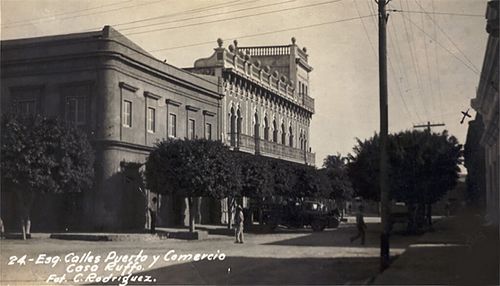
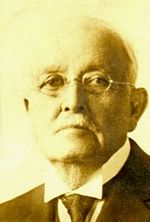 Antonio J. Ruffo Santacruz (1841-1926) was the most prominient businessman in La Paz. In 1860 he founded a department store, initially called “Don Antonio Ruffo", then “Ruffo Hermanos", and finally "La Perla de La Paz", which grew into the largest store of Baja California Sur and the northwestern part of Mexico. It offered a wide variety of goods which went from a kilo of sugar up to finest fabrics and fragrances from around the world as well as hardware tools necessary for the miners of El Triunfo and San Antonio. It was situated on the corner of calle Puerto and calle Comercio.
Antonio J. Ruffo Santacruz (1841-1926) was the most prominient businessman in La Paz. In 1860 he founded a department store, initially called “Don Antonio Ruffo", then “Ruffo Hermanos", and finally "La Perla de La Paz", which grew into the largest store of Baja California Sur and the northwestern part of Mexico. It offered a wide variety of goods which went from a kilo of sugar up to finest fabrics and fragrances from around the world as well as hardware tools necessary for the miners of El Triunfo and San Antonio. It was situated on the corner of calle Puerto and calle Comercio.
Antonio Ruffo was also involved in the pearl industry.
On 10 April Otto Rach, on Ruffo's behalf, acknowledged 3,625 vales with a total value of $1,000ABCS, Gobernación, vol. 642, exp. 150, so a suggested permutation could be
| from | to | total number |
total value |
|||
| Antonio Ruffo | 5c | 650 | $ 32.50 | |||
| 10c | 775 | 77.50 | ||||
| 20c | 700 | 140.00 | ||||
| 50c | 1,500 | 750.00 | ||||
| $1,000.00 |
On 20 May the government printing office (Imprenta del Gobierno) sent details of the vales it had printedABCS, Gobernación, vol. 642, exp. 150 letter F M González, Director to Secretario of Jefatura Política, 20 May 1915, including this $1, 000 for Antonio Ruffo. On 30 June a meeting of merchants, summoned by Jefe Político Eduardo Burns, noted that the commercial vales had mainly disappeared from circulation, so it was agreed, inter alia, that Antonio Ruffo would make a new issue of $6,000, and that the vales already issued would remain in circulation until the date already fixed, and collected by the issuersABCS, Gobernación, vol. 642, exp. 150.
On 8 August 1916 Antonio Ruffo handed in to the Comandancia Militar $1,000 in vales that it had issued, and which had been withdrawn in accordance with the circular of 21 (sic) July, to be incineratedABCS, Gobernación, vol. 658 2/2, exp.190.
So, in summary
| from | to | total number |
total value |
|||
| Antonio Ruffo | 5c | |||||
| 10c | ||||||
| 20c | ||||||
| 50c | ||||||
| $7,000.00 |
Rocholl, Ruffo y Compañía
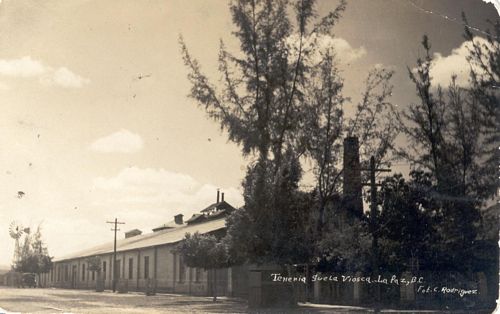
The tannery Viosca y Compañía was founded in 1903. In 1912 when Santiago Viosca died, Antonio Ruffo, who was a shareholder, arranged with Santiago’s widow, Isabel, to wind up the old company (on 21 August 1912) with Antonio Ruffo, William H. Rocholl, Arturo C. Nahl and a new shareholder, Max Hach, taking on the assets and liabilities under a new concern, Rocholl, Ruffo y CompaníaABCS, Ayuntamiento, D. 167. 124 Acta Constitutiva). On 12 April Rocholl, Ruffo y Compañía acknowledged receipt of $1,000 in vales, suggesting
| from | to | total number |
total value |
|||
| Rocholl, Ruffo y Compañía | 5c | 650 | $ 32.50 | |||
| 10c | 775 | 77.50 | ||||
| 20c | 700 | 140.00 | ||||
| 50c | 1,500 | 750.00 | ||||
| $1,000.00 |
We known of just one example of a vale issued pursuant to the agreement of 31 March, namely a cartón for 10 centavos issued by Rocholl, Ruffo y Cia. (who were one of the signatories to the agreement) and valid until 31 August. This is number 7741, dated 15 July 1915, and so could be part of a later issue.
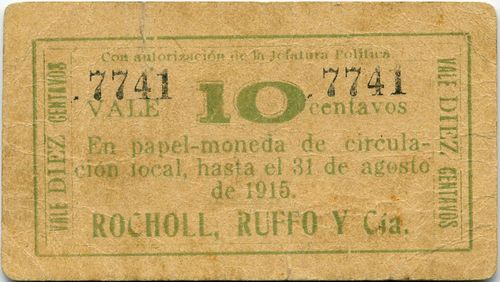
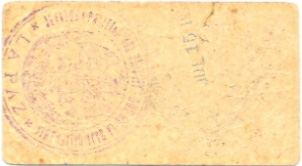 M854 10c Rocholl, Ruffo y Cía.
M854 10c Rocholl, Ruffo y Cía.
On 8 August 1916 Rocholl, Ruffo y Cia. handed in to the Comandancia Militar $1,000 in vales that it had issued, and which had been withdrawn in accordance with the circular of 21 (sic) July, to be incineratedABCS, Gobernación, vol. 658 2/2, exp.190.
So, in summary
| from | to | total number |
total value |
|||
| Rocholl, Ruffo y Cia. | 5c | |||||
| 10c | includes number 7741 | |||||
| 20c | ||||||
| 50c | ||||||
M. González e hijos Sucrs.
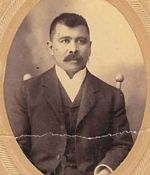
Miguel González had been involved with Antonio Ruffo but in 1890 he set up his own business with his sons. In 1907 his La Torre Eiffel, the largest building in the city, “had just augmented its vast stock with wool and silk fabrics, Mexican and imported cashmeres, Spanish fans, German guitars and mandolins. Friedman footwear and was expecting to receive French perfumery, and German earthenware and toys, all at cheap prices. La Torre Eiffel had branches in Sonora, Sinaloa and in the territory of Nayarit. González was also involved in the pearl industry.
Filemón Cecilio Piñeda Contreras was born in La Paz on 22 November 1868. He was a member of the town council of La Paz on several occasions from 1905 onwards. He served as accountant for the major stores in the town, La Perla de La Paz of Antonio Ruffo and La Torre Eiffel. He was later treasurer for the government of Agustín Arriola Martínez until his death in La Paz on 17 May 1922.
However, his major claim to fame was that he was, according to Armando Trasviña Taylor, “the first of the great poets of Baja California. He is also one of the most cultivated, since his entire work demonstrates a complete mastery of contemporary literary movements, which makes it more difficult to define him as a poet made, on the one hand, in the cauldrons of romanticism and, on the other, with the immutable presence of the rigidities of neoclassicism."
On 12 April Filemón C. Pineda acknowleged $1,000.00ABCS, Gobernación, vol. 642, exp. 150, so M. González e hijos Sucrs.

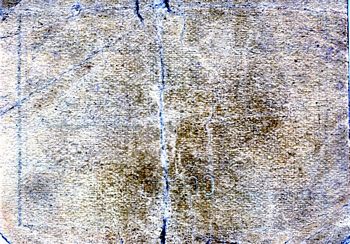 M833 20c M. González e hijos
M833 20c M. González e hijos
| from | to | total number |
total value |
|||
| M. González e hijos Sucrs | 5c | 650 | $ 32.50 | |||
| 10c | 775 | 77.50 | ||||
| 20c | 700 | 140.00 | ||||
| 50c | 1,500 | 750.00 | ||||
| $1,000.00 |
There was a second printing of $790.00, as on 20 May the government printing office (Imprenta del Gobierno) sent details of the vales it had printedABCS, Gobernación, vol. 642, exp. 150 letter F M González, Director to Secretario of Jefatura Política, 20 May 1915, including $1,000 and $790 for Antonio Ruffo. On 30 June a meeting of merchants, summoned by Jefe Político Eduardo Burns, noted that the commercial vales had mainly disappeared from circulation, so it was agreed, inter alia, that M. González e hijos Sucrs. would make a new issue of $5,000, and that the vales already issued would remain in circulation until the date already fixed, and collected by the issuersABCS, Gobernación, vol. 642, exp. 150.
The catalogues record, but do not illustrate, a 10c note from M. González e Hijos 10c[image needed].
On 8 August 1916 M. González e hijos, sucrs., handed in to the Comandancia Militar $2,000 in vales that it had issued, and which had been withdrawn in accordance with the circular of 21 (sic) July, to be incineratedABCS, Gobernación, vol. 658 2/2, exp.190.
So, in summary
| from | to | total number |
total value |
|||
| M. González e hijos Sucrs. | 5c | |||||
| 10c | ||||||
| 20c | ||||||
| 50c | ||||||
Felipe R. Cota
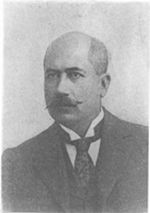 Felipe R. Cota was in 1911 treasurer of the Comité Democrático Californiano and later formed part of the short-lived Junta Gubernativa Neutral.
Felipe R. Cota was in 1911 treasurer of the Comité Democrático Californiano and later formed part of the short-lived Junta Gubernativa Neutral.
On 10 April Cota acknowledged $1,000ABCS, Gobernación, vol. 642, exp. 150, suggesting
| from | to | total number |
total value |
|||
| Felipe R. Cota | 5c | 650 | $ 32.50 | |||
| 10c | 775 | 77.50 | ||||
| 20c | 700 | 140.00 | ||||
| 50c | 1,500 | 750.00 | ||||
| $1,000.00 |
On 20 May the government printing office (Imprenta del Gobierno) sent details of the vales it had printedABCS, Gobernación, vol. 642, exp. 150 letter F M González, Director to Secretario of Jefatura Política, 20 May 1915, including $1,000 for Felipe R. Cota. On 30 June a meeting of merchants, summoned by Jefe Político Eduardo Burns, noted that the commercial vales had mainly disappeared from circulation, so it was agreed, inter alia, that Cota would make a new issue of $2,000, and that the vales already issued would remain in circulation until the date already fixed, and collected by the issuersABCS, Gobernación, vol. 642, exp. 150.
So, in summary
| from | to | total number |
total value |
|||
| Felipe R. Cota | 5c | |||||
| 10c | ||||||
| 20c | ||||||
| 50c | ||||||
| $3,000.00 |
Eduardo S. Carrillo
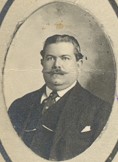 Eduardo S. Carrillo was a leading businessman who owned “El Emporio". In 1911 he was vice-presidente of the Comité Democrático Californiano and later formed part of the short-lived Junta Gubernativa Neutral.
Eduardo S. Carrillo was a leading businessman who owned “El Emporio". In 1911 he was vice-presidente of the Comité Democrático Californiano and later formed part of the short-lived Junta Gubernativa Neutral.
On 30 June a meeting of merchants, summoned by Jefe Político Eduardo Burns, it was agreed that Carrillo would make a issue of $1,000 in vales, to remain in circulation until the date already fixed, and collected by the issuersABCS, Gobernación, vol. 642, exp. 150.
On 2 August Urbano Angulo decreed in his decree núm. 2 that these vales should remain in circulation until 31 OctoberABCS, Gobernación, vol. 642bis, exp. 52.
On 25 October the accidental Comandante Militar, J. L.Yagomín, summoned Antonio Ruffo, M. González e hijos, Sucs., Rocholl, Ruffo & Co., Felipe R. Cota and Eduardo S. Carrillo to a meeting to discuss the local vales ABCS, Gobernación, vol. 642, exp. 150. At the meeting were Filemón C. Piñeda, representing Miguel González é hijos Sucesores; Guillermo Westerman, representing Rocholl Ruffo & Co., Otto Hach representing Antonio Ruffo; Aristeo Carlos Mendoza representing Felipe R. Cota and Eduardo S. Carrillo, for himself. The Comandante Militar said that according to his decree núm. 2 the vales were valid until 31 October but since it would be would be prejudicial to commerce to withdraw them they should remain in circulation until the Comandante Militar, Urbano Angulo, returned to town and could decide what to do. The others agreed and said they would notify the publicABCS, Gobernación, vol. 642, exp. 150.
Withdrawal
On 20 January 1916 the Comandante Militar, Urbano Angulo, sent a circular to the businesses of Antonio Ruffo, Miguel González e Hijos Sucs., Felipe R. Cota, Rocholl, Ruffo y Cia. and Eduardo S. Carrillo, that since their vales had completely deteriorated, they should withdraw them with the greatest speedABCS, Gobernación, vol. 658 2/2, exp.189: the circular (Circular que ordena retirar el papel-moneda fraccionario de algunas casas comerciales, La Paz, 20 January 1916) is at ABCS, Gobernación, vol. 658, exp. 190 but unavailable because of the state of deterioration.
However, it was not until 20 July that Urbano Angulo, noting that public employees were now being paid in silver, gave the holders of these private vales ten days to redeem them at the casas that had issued them and told the casas themselves to present them at the Comandancia Militar on 31 July. Soon after $3,000 were incineratedABCS, Gobernación, vol. 658 2/2, exp.190.
